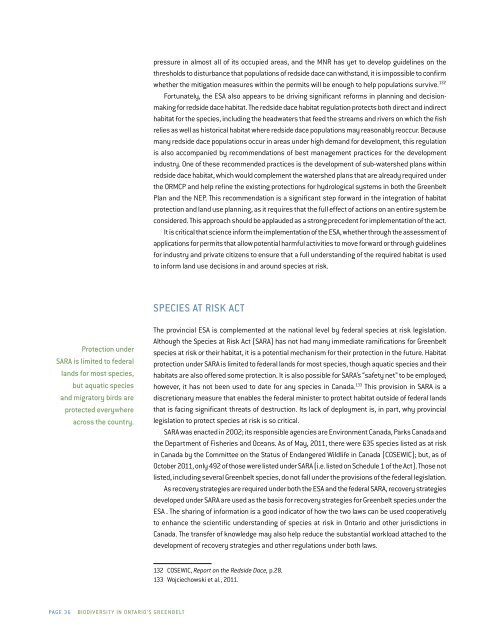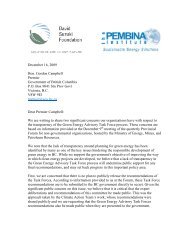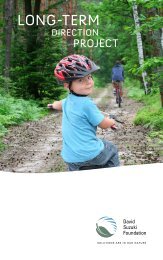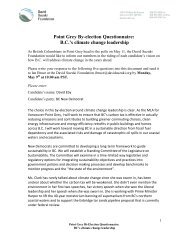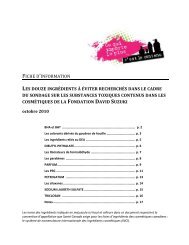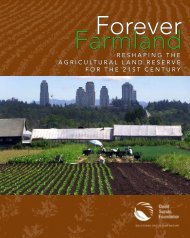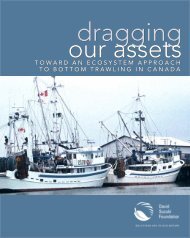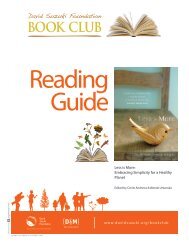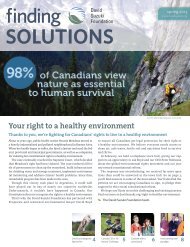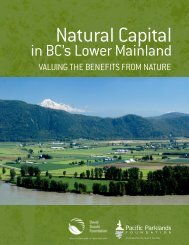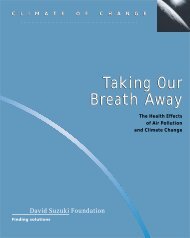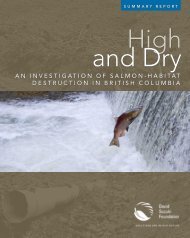Biodiversity in Ontario's Greenbelt (PDF) - David Suzuki Foundation
Biodiversity in Ontario's Greenbelt (PDF) - David Suzuki Foundation
Biodiversity in Ontario's Greenbelt (PDF) - David Suzuki Foundation
Create successful ePaper yourself
Turn your PDF publications into a flip-book with our unique Google optimized e-Paper software.
pressure <strong>in</strong> almost all of its occupied areas, and the MNR has yet to develop guidel<strong>in</strong>es on the<br />
thresholds to disturbance that populations of redside dace can withstand, it is impossible to confirm<br />
whether the mitigation measures with<strong>in</strong> the permits will be enough to help populations survive. 132<br />
Fortunately, the ESA also appears to be driv<strong>in</strong>g significant reforms <strong>in</strong> plann<strong>in</strong>g and decisionmak<strong>in</strong>g<br />
for redside dace habitat. The redside dace habitat regulation protects both direct and <strong>in</strong>direct<br />
habitat for the species, <strong>in</strong>clud<strong>in</strong>g the headwaters that feed the streams and rivers on which the fish<br />
relies as well as historical habitat where redside dace populations may reasonably reoccur. Because<br />
many redside dace populations occur <strong>in</strong> areas under high demand for development, this regulation<br />
is also accompanied by recommendations of best management practices for the development<br />
<strong>in</strong>dustry. One of these recommended practices is the development of sub-watershed plans with<strong>in</strong><br />
redside dace habitat, which would complement the watershed plans that are already required under<br />
the ORMCP and help ref<strong>in</strong>e the exist<strong>in</strong>g protections for hydrological systems <strong>in</strong> both the <strong>Greenbelt</strong><br />
Plan and the NEP. This recommendation is a significant step forward <strong>in</strong> the <strong>in</strong>tegration of habitat<br />
protection and land use plann<strong>in</strong>g, as it requires that the full effect of actions on an entire system be<br />
considered. This approach should be applauded as a strong precedent for implementation of the act.<br />
It is critical that science <strong>in</strong>form the implementation of the ESA, whether through the assessment of<br />
applications for permits that allow potential harmful activities to move forward or through guidel<strong>in</strong>es<br />
for <strong>in</strong>dustry and private citizens to ensure that a full understand<strong>in</strong>g of the required habitat is used<br />
to <strong>in</strong>form land use decisions <strong>in</strong> and around species at risk.<br />
Species at Risk Act<br />
Protection under<br />
SARA is limited to federal<br />
lands for most species,<br />
but aquatic species<br />
and migratory birds are<br />
protected everywhere<br />
across the country.<br />
The prov<strong>in</strong>cial ESA is complemented at the national level by federal species at risk legislation.<br />
Although the Species at Risk Act (SARA) has not had many immediate ramifications for <strong>Greenbelt</strong><br />
species at risk or their habitat, it is a potential mechanism for their protection <strong>in</strong> the future. Habitat<br />
protection under SARA is limited to federal lands for most species, though aquatic species and their<br />
habitats are also offered some protection. It is also possible for SARA’s “safety net” to be employed;<br />
however, it has not been used to date for any species <strong>in</strong> Canada. 133 This provision <strong>in</strong> SARA is a<br />
discretionary measure that enables the federal m<strong>in</strong>ister to protect habitat outside of federal lands<br />
that is fac<strong>in</strong>g significant threats of destruction. Its lack of deployment is, <strong>in</strong> part, why prov<strong>in</strong>cial<br />
legislation to protect species at risk is so critical.<br />
SARA was enacted <strong>in</strong> 2002; its responsible agencies are Environment Canada, Parks Canada and<br />
the Department of Fisheries and Oceans. As of May, 2011, there were 635 species listed as at risk<br />
<strong>in</strong> Canada by the Committee on the Status of Endangered Wildlife <strong>in</strong> Canada (COSEWIC); but, as of<br />
October 2011, only 492 of those were listed under SARA (i.e. listed on Schedule 1 of the Act). Those not<br />
listed, <strong>in</strong>clud<strong>in</strong>g several <strong>Greenbelt</strong> species, do not fall under the provisions of the federal legislation.<br />
As recovery strategies are required under both the ESA and the federal SARA, recovery strategies<br />
developed under SARA are used as the basis for recovery strategies for <strong>Greenbelt</strong> species under the<br />
ESA . The shar<strong>in</strong>g of <strong>in</strong>formation is a good <strong>in</strong>dicator of how the two laws can be used cooperatively<br />
to enhance the scientific understand<strong>in</strong>g of species at risk <strong>in</strong> Ontario and other jurisdictions <strong>in</strong><br />
Canada. The transfer of knowledge may also help reduce the substantial workload attached to the<br />
development of recovery strategies and other regulations under both laws.<br />
132 COSEWIC, Report on the Redside Dace, p.28.<br />
133 Wojciechowski et al., 2011.<br />
Page 36<br />
<strong>Biodiversity</strong> <strong>in</strong> Ontario’s greenbelt


